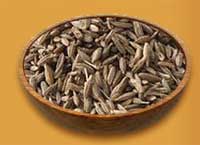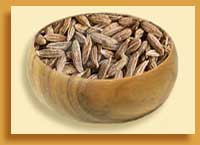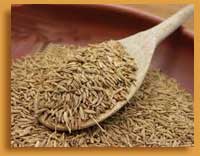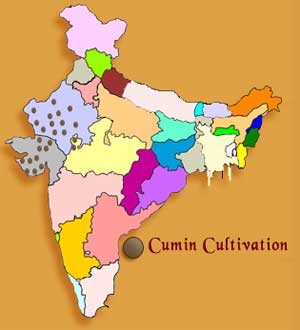CUMIN
Introduction
Cumin is a sweet-smelling spice with a distinctive bitter flavor and physically powerful, warm fragrance due to its plentiful oil content. Cumin seeds are actually the tiny dehydrated fruit of a yearly plant in the aromatic plant family. Inhabitant to the Mediterranean, cumin is hotter to the taste, lighter in color, and bigger than caraway, another spice it is sometimes confused with. Sold whole or ground, the seeds are of three colors: amber, white or black. Amber is more broadly available, but the black has such a multifarious flavor it should not be substituted for the other two. Cumin is a popular element in Middle Eastern, Asian, Mediterranean and Mexican cuisines, and is one of the main components in curry powder. Cumin seeds are spicy, strong little things with the ability to considerably change the taste of a dish.
The exterior of the fruit has 5 primary ridges, on the other hand has 4 less separate secondary ridges bearing abundant short hairs. The plant is 15 to 50 cm high. The aromatic seed like fruit is extended, ovoid, 3 to 6 mm long, somewhat bitter and has a warm flavor. The flowers are white or rose colored in small umbels.
Common Names
Cuminum cyminum L is the biological scientific name of cumin. In Indian languages such as in Hindi it is called as Jira, Jeera, Zira or Safaid jeera or Zeera, in Bengali it is called as Safaid jira or Zeera, in Gujarati it is called as Jiru or Jeeru, in Kannada it is called as Jeeriege, in Kashmiri it is called as Zyur, in Malayalam it is called as Jeerakam, in Marathi it is called as Jeregire, in Oriya it is called as Jira, Jeera, in Sindhi it is called as Zero, in Sanskrit it is called as Jiraka, Jira, in Tamil it is called as Ziragum or Jeeragam, in Telugu it is called as Jidakara or Jikaka.
History
Cumin has been in use since ancient times. Seeds excavated at the Syrian location Tell ed-derva have been dated to the second millennium BC. There is also information about quite a lot of new kingdom levels of ancient Egyptian archaeological sites. Initially cultivated in Iran and in the Mediterranean region, cumin is pointed out in the Bible in both the Old testament and the New testament. The ancient Greeks kept cumin in the dining stall in its own container as much as pepper is habitually kept nowadays, and this practice continues in Morocco.Cumin was also used greatly in the ancient Roman cuisine. During the Middle Ages, cumin fell out of favor in Europe, except in Spain and Malta.
It was brought to the Americas by Spanish and Portuguese colonists. There are a number of different types of cumin but the most well-known ones are black and green cumin which are both used in Persian cuisine. It has since returned to acting of kindness in parts of Europe. Today, it is commonly grown in Iran, Uzbekistan, Tajikistan, Turkey, Morocco, Egypt, India, Syria, Mexico, Chile, and China. The plant occurs as an exceptionally casual one in the British Isles, mainly in southern England, but the regularity of its occurrence has declined greatly. Cumin is a humid plant and is cultivated as a rabbi crop in areas where atmospheric dampness during February-March is low.
Uses
Cooking
Cumin seeds are used as a spice for their characteristic flavor and smell. It is internationally popular and is an indispensable flavoring agent in many popular cuisines of the world. Cumin can be found in some Dutch cheese, such as Leyden cheese, and in some conventional breads of France. It is commonly used in conventional Brazilian cuisine. Cumin can be a component of Chilli powder that is often a Texan or Mexican-style, and is found in achiote blends. Cumin can be used ground or as whole seeds. It helps to include an unsophisticated and warm feeling to cooking, creating it a staple in certain stews and soups, as well as curries and chili.
Medicine
Cumin, along with ghee and a crowd of other spices, plays a very important role in the Ayurvedic medicinal traditions. Cumin extract is more effective at reducing blood glucose and AGE production than glibenclamide, an anti-diabetic drug in diabetic patients. Oral doses of cumin on consecutive days improves the immune system with compromised immune systems due to restraint-induced stress. These effects were noticeable by a decrease in elevated cortisol and adrenal gland size, an increase in the weight of the thymus and spleen, and replenishment of depleted T cells. This conventional herbal remedy has many uses. It is a refreshment as well as a great herb for digestive disorders and even as an antibacterial of sorts.
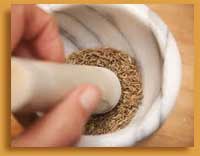
The seeds themselves are rich in iron and are considered to help arouse the secretion of enzymes from the pancreas which can help absorb nutrients into the system. It has also been shown to increase the power of the liver's ability to detoxify the human body. Cumin seeds may also have anti-carcinogenic possessions. In one study, cumin was shown to guard laboratory fauna from developing stomach or liver tumors. This cancer-protective effect may be due to cumin's persuasive free radical scavenging abilities as well as the ability it has shown to improve the liver's detoxification enzymes. Yet, since free radical scavenging and detoxification are significant considerations for the general continuation of wellness, cumin's contribution to wellness may be even further than successful. It is used as a condiment, and is a component in curry powders, seasonings of breads, cakes and cheese. It is engaged in native dishes of Central and South America. In medicine, it is used as a refreshment, carminative, stomachic and astringent. Cumin seed oil is used in the perfume industry and for flavoring liqueurs and cordials.
Nutritional Value
Although cumin seeds contain a relatively greater percentage of iron, extremely great quantities of cumin would need to be consumed for it to serve as a significant dietary source. 1tbsp of cumin spices have the following dietary information:
- Calories: 22
- Fat (g): 1.34
- Carbohydrates (g): 2.63
- Fibers (g): 0.6
- Protein: 0.25
Cumin Cultivation in India
